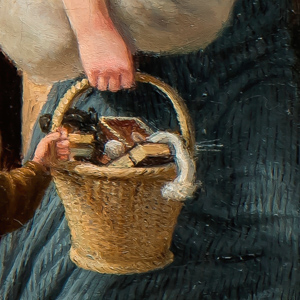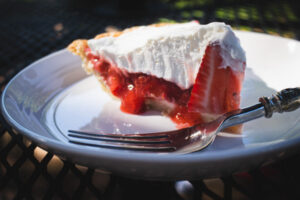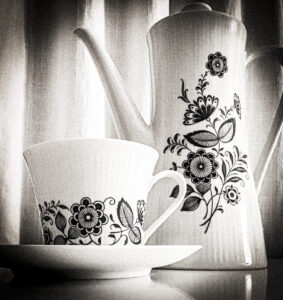A Pan for All Seasons
The Timeless & Timely Cast Iron Skillet

Mrs. April Jaure
My husband and I recently passed a pleasant afternoon picking through the treasures of a few of our local antique shops. We meandered the aisles hoping to rescue some storied artifact from obsolescence. We returned from our excursion with only a solitary candlestick. But along the way, we couldn’t help but notice the grand abundance of vintage cast iron skillets being offered for sale.
Cast iron skillets are great for a number of reasons, not the least of which is that even after decades of use they won’t wear out. This, of course, explains their ubiquitous presence at antique shops and vintage stores. This is a one-time purchase that can serve you for generations. You can use it your whole life and then give it to your grandchildren, still in perfect shape. Try doing that with your aluminum Teflon stuff.
Cast iron skillets also have other advantages over most types of cookware. One is that, unlike stainless steel, cast iron emits more heat from its surface; cast iron will heat foods through. This property of cast iron makes it ideal for pan-searing meats. With cast iron, meat is far less likely to be burnt on the outside and raw on the inside.
Cast iron is also highly versatile. It can be used on the stove-top for cooking meats and simmering sauces and also in the oven for roasting and baking. In our home, we sometimes use our skillet to make a one-pot meal as we may pan-sear some meat, then add vegetables, and then finish it off in the oven. Other favorite uses are making corn tortillas on the stovetop and baking cornbread in the oven. We have also been known to use our large skillet to bake sourdough pizza crusts in the oven.
There are a few minor idiosyncrasies of cast iron, however. One is that cast iron cookware must be preheated to avoid cold spots, which can cause food to not heat evenly. For this reason, it is best to heat the pan on the stove for a few minutes before adding food. Another is that a cast iron skillet must be properly seasoned before use. Once seasoned, the skillet will develop a non-stick surface that rivals conventional non-stick cookware, but without the tendency to get scratched or flake non-stick chemicals into food. A properly seasoned cast iron pan poses no such danger of scratching or flaking. If anything does leach into food, it would only be a little bit of iron, which is beneficial.
Caring for cast iron is easy, once it has been seasoned. Wash it as you would any other pan, then heat it on the stove to dry thoroughly. I recommend you coat it with a little bit of flaxseed oil after drying to ensure that it maintains its smooth, non-stick surface. Some say that cast iron should not be used when cooking acidic foods like tomato-based sauces. We ignore this advice since our cast iron is well-seasoned. After each use, we add a little dab of flaxseed oil to the pan, spread it around, and heat the pan till smoking. We do not avoid acidic foods as it seems unlikely that a little tomato sauce could undo all those layers of bonded, polymerized oil on the pan.
There are many opinions about the proper way to season and care for a cast iron pan, and this may put some people off from buying one. Lucky for you, over the last decade, my husband and I have done quite a bit of research (a.k.a. trial and error experiments) on the subject, the fruits of which we happily share below.
Materials
- Food-grade organic flax-seed oil (Don’t compromise on the type of oil. Flax-seed oil will dry into a hard, clear surface that when heated properly and will form a chemical bond to your pan).
- Cast Iron Skillet
Method
- Wash your skillet with soap and water and scrub it thoroughly, especially if you bought a used or vintage skillet. If needed, use a metal scrubby. Dry the pan well by heating it on the stove until it starts to smoke. A new cast iron skillet may come pre-seasoned, but I recommend seasoning it again yourself.
- Once cool, place a small dab of the flaxseed oil in the pan and, using a paper towel, coat the entire pan, inside and out and including the handle, with the oil. The pan will have a nice sheen of oil. With a clean paper towel, wipe all this off until it looks dry. Now the layer of oil is thin enough to form a chemical bond with your pan when heated.
- Place the skillet upside down on the middle rack of your oven and preheat to 450°F, or even 500°F if your oven goes that high. The pan can warm up along with the oven.
- Bake for an hour. Turn off the oven and then let the skillet cool in the oven for two hours.
- Repeat steps 2-4 five more times. Yes, I know it’s going to be a little tedious to do this over and over. The result, however, is a tough non-stick pan with polymerized oil that is bonded to the skillet and it will not chip, crack, or flake off.
Maintenance
- Despite myths, once your skillet is seasoned properly, you can put it in soapy water and wash it, though it should not be left to soak in the water.
- Rust is the enemy of cast iron, so dry it well. Place it on a burner and heat it until all the water has evaporated. Once the skillet is hot, place a little dab of flaxseed oil and carefully rub it around the inside of the skillet with a paper towel. Leave it on the burner until it starts to smoke and then turn off the burner and allow it to cool.
You needn’t fear cast iron. Though it requires some attention at first, it can reward your efforts with many dependable years of non-stick cooking. If you find that you have some time and a little extra cash on hand, I recommend you go “picking” too. Enjoy looking at antique furniture and decor, but come home with cast iron cookware.
Of course, buying new is always an option if you prefer. Whatever your choice, I think you’ll find that if you properly season your cast iron and thoroughly dry it after use, your pan will live a long, happy skillet life, serving countless family meals for you and the generations to follow.



















